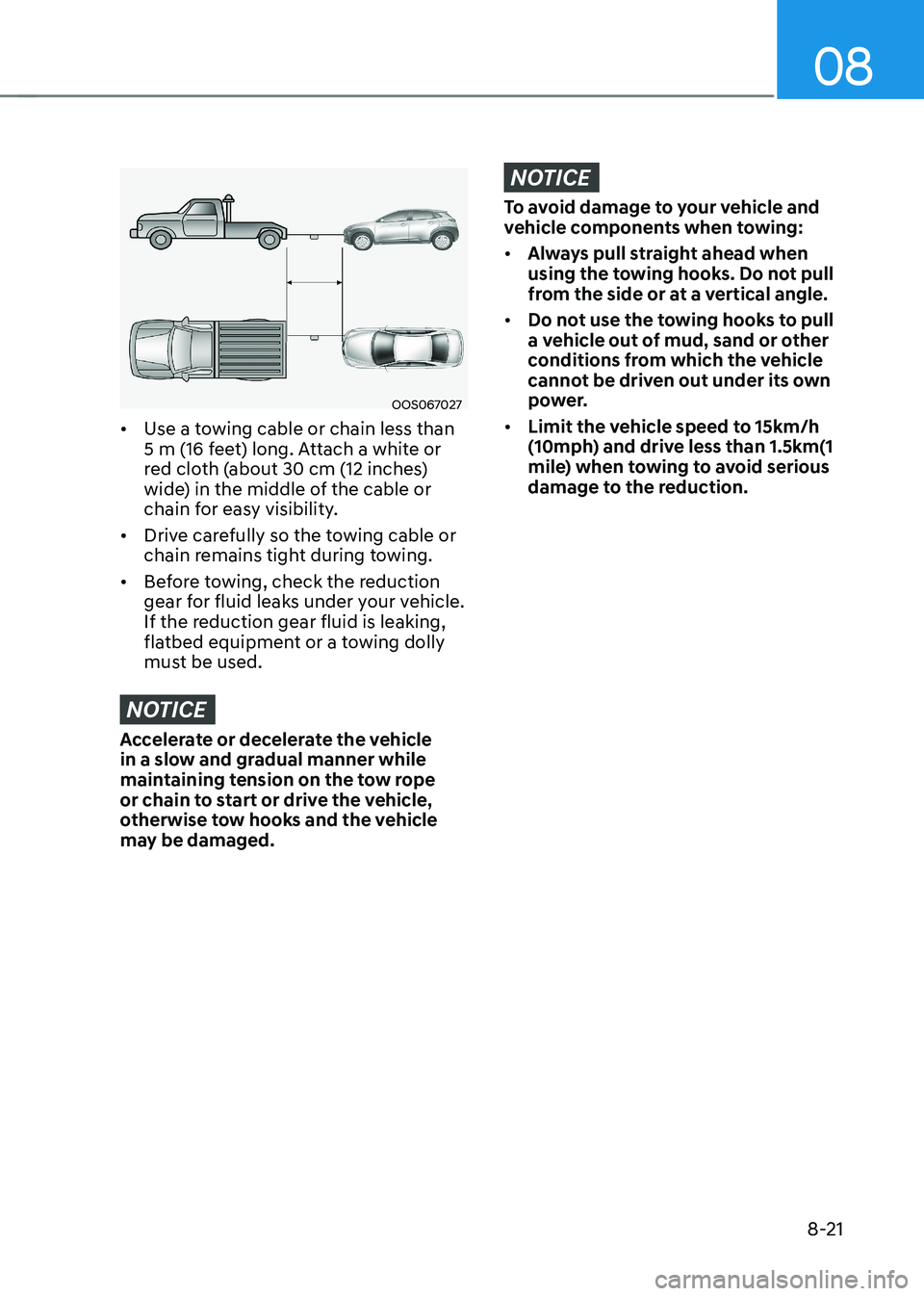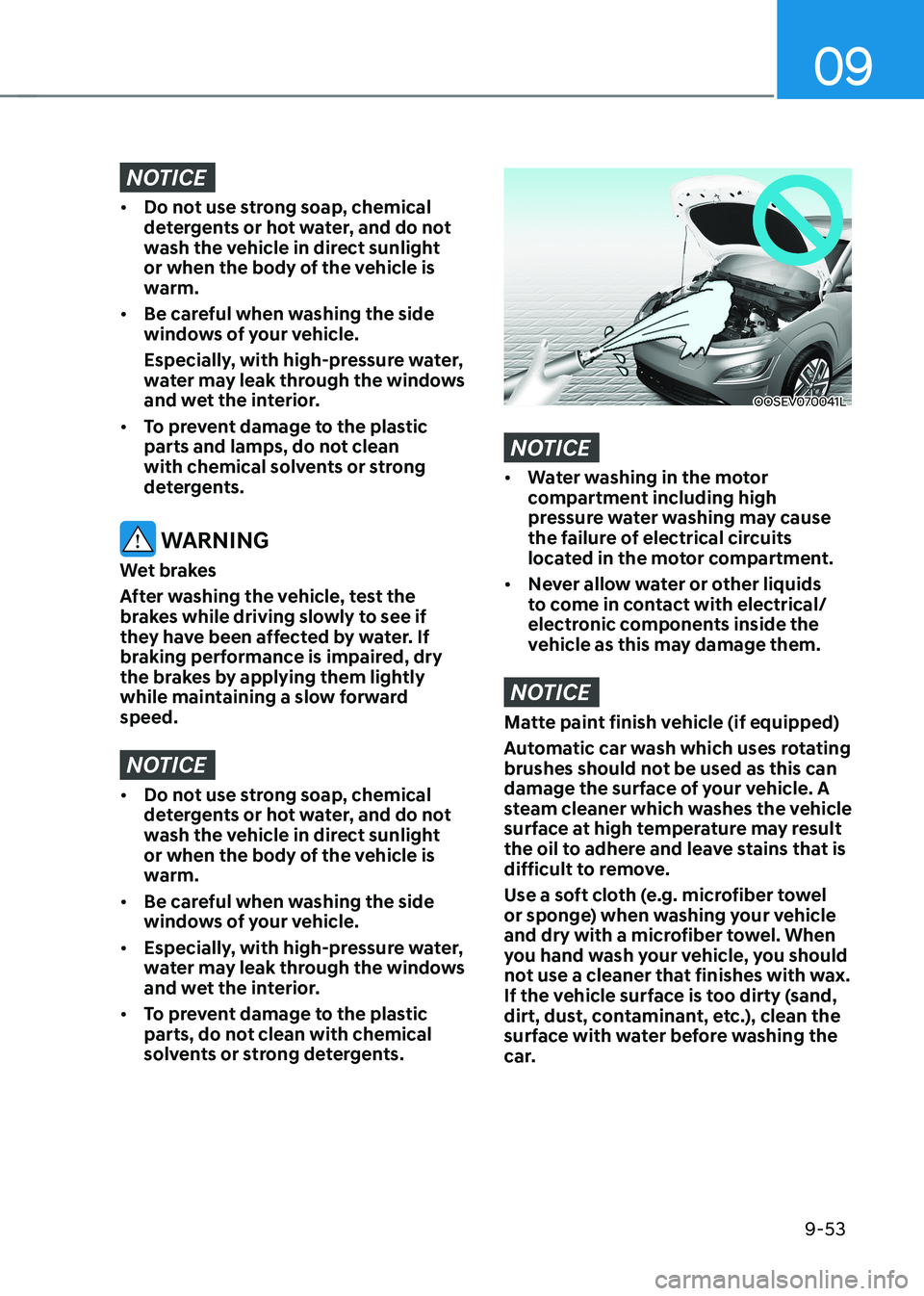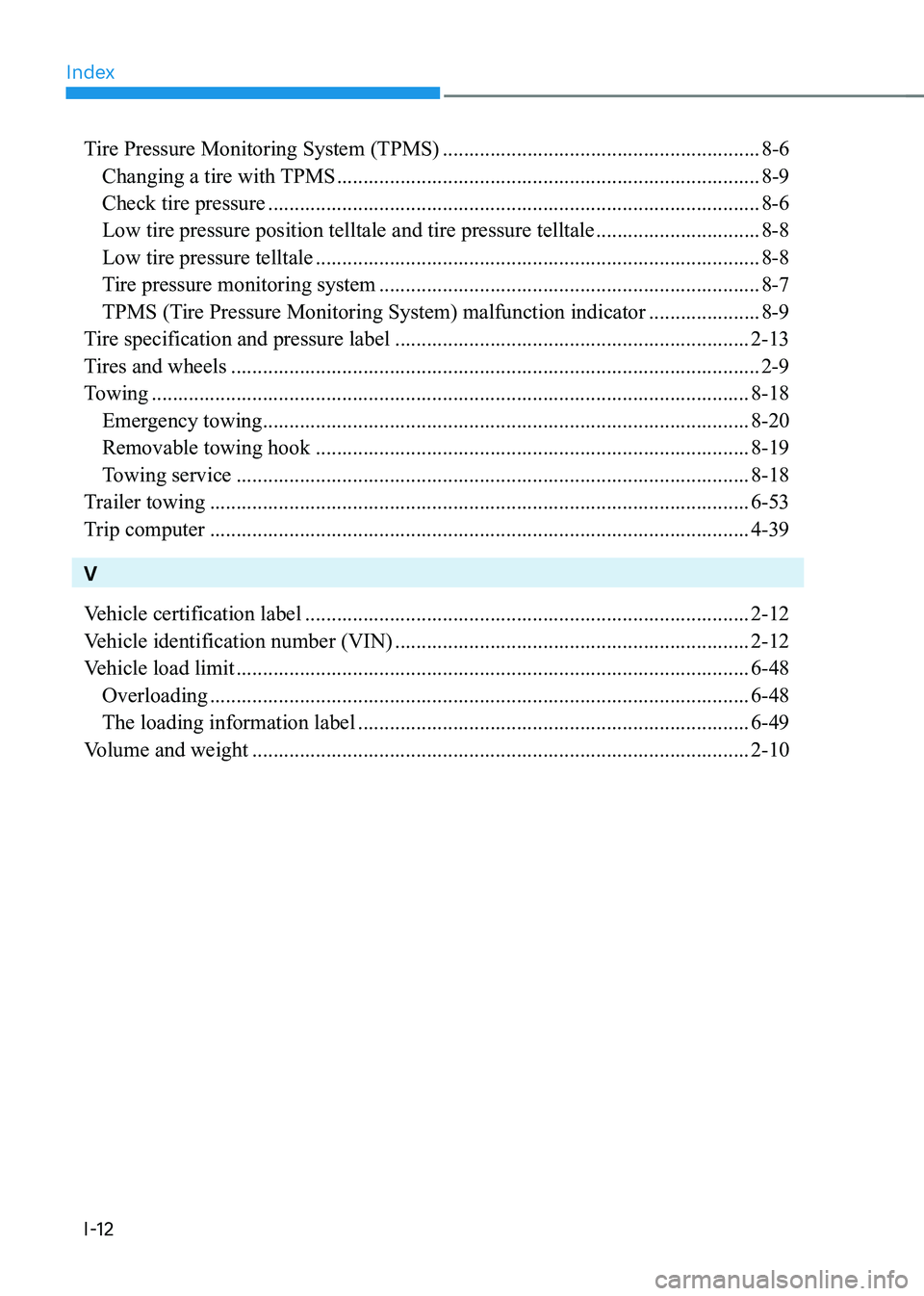2023 HYUNDAI KONA EV tow
[x] Cancel search: towPage 471 of 548

Emergency situations
8-16
How to adjust tire pressure
OIGH067043
OOSEV060007L
1. Park your vehicle in a safe location.
2. Connect the filling hose (3) of the compressor directly to the tire valve.
3. Plug the compressor power cord into the vehicle power outlet.
4. Adjust the tire inflation pressure to the
recomended tire inflation.
With the Vehicle is ON (
indicator
ON), proceed as follows.
- To increase the inflation pressure : Switch on the compressor. To
check the current inflation pressure
setting, briefly switch off the
compressor.
- To reduce the inflation pressure:
Press the button (9) on the
compressor.
NOTICE
Do not let the compressor run for more
than 10 minutes, otherwise the device
will overheat and may be damaged.
Information
The pressure gauge may show higher than
actual reading when the compressor is
running. To get an accurate tire reading,
the compressor needs to be turned off.
CAUTION
Do not use the sealant when the tire
pressure only needs to be adjusted.
WARNING
The tire inflation pressure must be at
least 220 kPa (32 psi). If it is not, do not
continue driving.
Call for road side service or towing.
Page 473 of 548
![HYUNDAI KONA EV 2023 Owners Manual Emergency situations
8-18
Towing service
OOSEV068009
A
A
[A] : Dollies If emergency towing is necessary,
we recommend having it done by
an authorized HYUNDAI dealer or a
commercial tow-truck servi HYUNDAI KONA EV 2023 Owners Manual Emergency situations
8-18
Towing service
OOSEV068009
A
A
[A] : Dollies If emergency towing is necessary,
we recommend having it done by
an authorized HYUNDAI dealer or a
commercial tow-truck servi](/manual-img/35/56170/w960_56170-472.png)
Emergency situations
8-18
Towing service
OOSEV068009
A
A
[A] : Dollies If emergency towing is necessary,
we recommend having it done by
an authorized HYUNDAI dealer or a
commercial tow-truck service.
Proper lifting and towing procedures
are necessary to prevent damage to
the vehicle. The use of wheel dollies or
flatbed is recommended.
It is acceptable to tow the vehicle with
the rear wheels on the ground (without
dollies) and the front wheels off the
ground. If any of the loaded wheels or suspension
components are damaged or the vehicle
is being towed with the front wheels on
the ground, use a towing dolly under the
front wheels.
When being towed by a commercial tow
truck and wheel dollies are not used,
the front of the vehicle should always be
lifted, not the rear.
CAUTION
• Do not tow the vehicle with the front
wheels on the ground as this may
cause damage to the vehicle.
OOS067022
• Do not tow with sling-type
equipment. Use wheel lift or flatbed
equipment.
OOS067021
towing
Page 474 of 548

08
8-19
When towing your vehicle in an
emergency without wheel dollies:
1. While depressing the brake pedal
shift to the N (Neutral) position and
turn the vehicle off. The START/STOP
button will be in the ACC position.
2. Release the parking brake.
CAUTION
Failure to place the shift lever in N
(Neutral) may cause internal damage to
the vehicle.
Removable towing hook
OOSEV060010L
1. Open the tailgate, and remove the towing hook from the tool case. The
tool case is placed under the luggage
tray.
„„Front
OOSEV060011L
„„Rear
OOSEV060012L
2. Remove the hole cover pressing the lower part of the cover on the bumper.
3. Install the towing hook by turning it clockwise into the hole until it is fully
secured.
4. Remove the towing hook and install
the cover after use.
Page 475 of 548

Emergency situations
8-20
Emergency towing
If towing is necessary, we recommend
you have it done by an authorized
HYUNDAI dealer or a commercial tow truck service.
If a towing service is not available in
an emergency, your vehicle may be
temporarily towed using a cable or chain
secured to the emergency towing hook
at the front (or rear) of the vehicle.
Use extreme caution when towing the
vehicle with a cable or chain. A driver
must be in the vehicle to steer it and
operate the brakes.
Towing in this manner may be done
only on hard-surfaced roads for a short
distance and at low speeds. Also, the
wheels, axles, power train, steering and
brakes must all be in good condition.
CAUTION
The driver must be in the vehicle for
steering and braking operations when
the vehicle is being towed. Passengers
other than the driver must not be in the
vehicle. Always follow these emergency towing
precautions: •
While depressing the brake pedal
shift to the N (Neutral) position and
turn the vehicle off. The START/STOP
button will be in the ACC position.
• Release the parking brake.
• Depress the brake pedal with more
force than normal as you will have
reduced braking performance.
• More steering effort will be required
because the power steering system will be disabled.
• Use a vehicle heavier than your own to
tow your vehicle.
• The drivers of both vehicles should
communicate with each other
frequently.
• Before emergency towing, check that
the hook is not broken or damaged.
• Fasten the towing cable or chain
securely to the hook.
• Do not jerk the hook. Apply steady
and even force.
Page 476 of 548

08
8-21
OOS067027
• Use a towing cable or chain less than
5 m (16 feet) long. Attach a white or
red cloth (about 30 cm (12 inches)
wide) in the middle of the cable or
chain for easy visibility.
• Drive carefully so the towing cable or
chain remains tight during towing.
• Before towing, check the reduction
gear for fluid leaks under your vehicle.
If the reduction gear fluid is leaking,
flatbed equipment or a towing dolly
must be used.
NOTICE
Accelerate or decelerate the vehicle
in a slow and gradual manner while
maintaining tension on the tow rope
or chain to start or drive the vehicle,
otherwise tow hooks and the vehicle
may be damaged.
NOTICE
To avoid damage to your vehicle and
vehicle components when towing: • Always pull straight ahead when
using the towing hooks. Do not pull
from the side or at a vertical angle.
• Do not use the towing hooks to pull
a vehicle out of mud, sand or other
conditions from which the vehicle
cannot be driven out under its own
power.
• Limit the vehicle speed to 15km/h
(10mph) and drive less than 1.5km(1
mile) when towing to avoid serious
damage to the reduction.
Page 529 of 548

09
9-53
NOTICE
• Do not use strong soap, chemical
detergents or hot water, and do not
wash the vehicle in direct sunlight
or when the body of the vehicle is
warm.
• Be careful when washing the side
windows of your vehicle.
Especially, with high-pressure water,
water may leak through the windows
and wet the interior.
• To prevent damage to the plastic
parts and lamps, do not clean
with chemical solvents or strong
detergents.
WARNING
Wet brakes
After washing the vehicle, test the
brakes while driving slowly to see if
they have been affected by water. If
braking performance is impaired, dry
the brakes by applying them lightly
while maintaining a slow forward speed.
NOTICE
• Do not use strong soap, chemical
detergents or hot water, and do not
wash the vehicle in direct sunlight
or when the body of the vehicle is
warm.
• Be careful when washing the side
windows of your vehicle.
• Especially, with high-pressure water,
water may leak through the windows
and wet the interior.
• To prevent damage to the plastic
parts, do not clean with chemical
solvents or strong detergents.
OOSEV070041L
NOTICE
• Water washing in the motor
compartment including high
pressure water washing may cause
the failure of electrical circuits
located in the motor compartment.
• Never allow water or other liquids
to come in contact with electrical/
electronic components inside the
vehicle as this may damage them.
NOTICE
Matte paint finish vehicle (if equipped)
Automatic car wash which uses rotating
brushes should not be used as this can
damage the surface of your vehicle. A
steam cleaner which washes the vehicle
surface at high temperature may result
the oil to adhere and leave stains that is
difficult to remove.
Use a soft cloth (e.g. microfiber towel
or sponge) when washing your vehicle
and dry with a microfiber towel. When
you hand wash your vehicle, you should
not use a cleaner that finishes with wax.
If the vehicle surface is too dirty (sand,
dirt, dust, contaminant, etc.), clean the
surface with water before washing the
car.
Page 547 of 548

Index
I-12
Tire Pressure Monitoring System (TPMS) ............................................................8-6
Changing a tire with TPMS ................................................................................ 8-9
Check tire pressure ............................................................................................. 8-6
Low tire pressure position telltale and tire pressure telltale ...............................8-8
Low tire pressure telltale .................................................................................... 8-8
Tire pressure monitoring system ........................................................................ 8-7
TPMS (Tire Pressure Monitoring System) malfunction indicator .....................8-9
Tire specification and pressure label ................................................................... 2-13
Tires and wheels .................................................................................................... 2-9
Towing ................................................................................................................. 8-18
Emergency towing ............................................................................................ 8-20
Removable towing hook .................................................................................. 8-19
Towing service ................................................................................................. 8-18
Trailer towing ...................................................................................................... 6-53
Trip computer ...................................................................................................... 4-39
V
Vehicle certification label .................................................................................... 2-12
Vehicle identification number (VIN) ................................................................... 2-12
Vehicle load limit ................................................................................................. 6-48
Overloading ...................................................................................................... 6-48
The loading information label .......................................................................... 6-49
Volume and weight .............................................................................................. 2-10